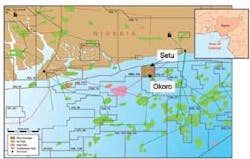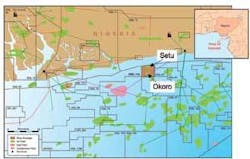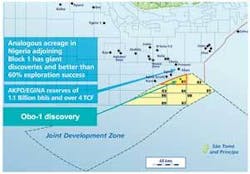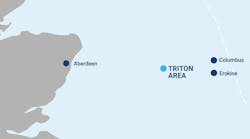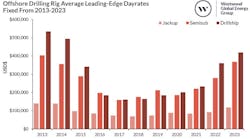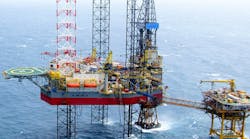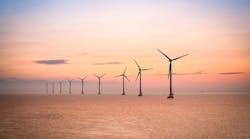Jeremy Beckman, Editor, Europe
Nigeria needs widespread oilfield investment to reach its output target of 4.5 MMb/d by 2012. At the same time, the government wants to scale back its spending commitments.
Under the existing joint venture arrangement, NNPC takes an automatic 60% interest in large-scale development projects. But the government is now leaning toward a production-sharing model, bringing it revenue via taxation. According to Afren’s Chief Executive Brian O’Cathain, “the government is in negotiations with the majors on how to implement that change. We think this process will lead to some form of asset rationalization.”
Afren, a London-based independent, hopes to capitalize on this situation. The company was formed in 2004 by a team including former Nigerian minister of Petroleum Resources, Dr. Rilwanu Lukman. Its stated aim at the time was to become Africa’s leading independent E&P company.
So far, the strategy is working. Since its initial listing on London’s Alternative Investment Market in March last year, the company has acquired near-term offshore development opportunities in the Niger Delta region. It also participated early this year in the first deepwater exploration well in the Nigeria/Sao Tome and Principe Joint Development Zone (JDZ). Elsewhere, Afren has farmed into three low-cost, shallow-water licenses off southern Gabon, and has acquired a stake in the La Noumbi onshore exploration block in Congo (Brazzaville).
The near-term priority is demonstrating Afren’s competence as a development operator. In October, the jackupSeadrill-7 began drilling the first of two new appraisal wells on Okoro/Setu development on OML 112 offshore Nigeria. If successful, this would give Afren leverage to farm into the Majors’ onshore portfolios.
“We think what has happened in the North Sea in recent years could be replicated in West Africa,” says O’Cathain, “with the Majors looking to sell some of their mature offshore and onshore holdings to concentrate on deepwater opportunities.”
Lukman, the original driving force behind Afren, was very supportive of Nigeria’s “indigenization” program during his time as a minister. Under this scheme, introduced in the early 1990s, the government made available to local companies 116 marginal discoveries, with various incentives, including generous fiscal terms.
Around 40 indigenous operators picked up exploration licenses. But while some proved to be technically and organizationally competent, others were either not up to the mark, or struggled to attract investment capital for their limited holdings (typically one or two blocks). This led to the government revoking 31 of the licenses in 2000, and imposing stricter selection criteria for its subsequent marginal field licensing round in 2003.
Lukman’s idea had been to create an Africa-focused oil company run on traditional E&P lines and headquartered in London where it could secure direct access to capital from international finance institutions. This would make it a sound partner initially to help indigenous Nigerian companies accelerate marginal field developments, later partnering international companies in larger-scale projects.
London is emerging as the center of the global E&P business, O’Cathain claims. “It’s much easier to raise funds in London these days for international projects than in New York or Toronto, which seem to be more focused on North American operations.”
O’Cathain, an experienced geologist and petroleum engineer, had come from Tullow Oil, where he was instrumental in the acquisition in 2004 of Cape Town-based Energy Africa. This was the most successful Pan-African independent of recent times, with high-profile production interests off Equatorial Guinea and Gabon.
Aside from Lukman - a non-executive director - the Afren board has solid African credentials. Managing director Egbert Imomoh formerly was deputy M.D. of Shell Petroleum Development Co. (Nigeria). Guido Pas, another non-executive director, was a founding partner of Addax Group, the largest independent oil and gas producer in Nigeria. And chief financial officer Dr. Osman Shahenshah previously was with the World Bank’s IFC division, focusing on West African natural resources.
The Niger Delta fields development team is headed by Alan Hunt, formerly senior engineer for Shell International in Nigeria. Drilling manager Graham Ross, a more recent recruit to Afren, worked in a similar capacity for Premier Oil offshore Guinea and Gabon.
Afren has interests in two Nigerian offshore mining licenses, OML 112 and 90. The former contains two undeveloped fields, Okoro and Setu, in 6-12 m water depth. Okoro was discovered by Japan Petroleum, the original licensee, via two wells drilled in 1973-74. However, Amni International Development Co., which picked up the acreage under the 1993 indigenous awards program, decided to focus instead on the Ima field in the far west of the license.
Ima has been developed through the production jackupCliffs Langley. As the field started to decline, Amni switched its attention to the Setu prospect, north of Okoro. An exploratory well drilled on Setu in 2002 tested oil at commercial rates across five reservoir sands, but a follow-up appraisal well had to be shut in following technical problems.
Progress was then constrained by a lack of funds, forcing Amni to seek outside help for both Setu and Okoro. In June this year, Afren agreed to act as the technical and finance partner for the two fields, financing appraisal and development work with an estimated overall cost in excess of $200 million. Under this arrangement, Afren will recover these costs preferentially through 90% of cash flow from production; pre- and post-cost recovery; both partners will receive 50% of profit oil.
The two fields are well covered by good quality 3D seismic, and therefore are reasonably well understood. However, some uncertainties remain, and the two appraisal wells on Okoro/Setu will attempt to prove up further reserves. Combined most likely reserves are estimated currently at 35 MMbbl.
“We aim to appraise the area with two wells in October - November 2006. Shortly afterwards, we intend to submit a full development plan,” says O’Cathain. “It’s very important for our credibility that we go on to execute that program seamlessly, ahead of schedule if possible, and within budget.” He anticipates no delays from the government, with NNPC not involved in the development. “The Department of Petroleum Resources is pretty good at pushing approvals forward for these types of projects,” he says.
Afren also has secured the GlobalSantaFe jackupAdriatic VI for the development drilling, starting on Okoro next summer. The most likely plan is to bring the field into production early in 2008, via up to five production wells, between Okoro and Setu. First production is expected in Q1 08. All the wells should be relatively easy to drill.
Amec in London recently commenced concept screening. Both fields probably will be developed through separate wellhead platforms, which could be fabricated fairly quickly by a local yard. In each case, three-phase production would be exported through flowlines to a processing center, featuring gas lift and water injection capability.
Setu’s 44°API oil is relatively gassy, and this gas would be redirected to help lift Okoro’s 25° crude. “Because of these different characteristics, we may need to include separate process trains for each field,” O’Cathain points out. “But once the crude is stabilized, it can be blended.” The processing facility could be a leased FPSO in 20-m water depth, or possibly theCliffs Langley, if production ceases at Ima. Depending on the results of the appraisal well, combined peak production could be anything from 15-20,000 b/d in 2008.
Ogedeh in Chevron-operated OML 90 is an elongated oilfield, discovered in 1993, which was transferred to Bicta Energy and Management System under the 2003 marginal fields program. Afren farmed into Ogedeh in summer 2005, and will finance appraisal and development (budgeted at $75 million), under a similar cost recovery arrangement to Okoro/Setu. The field’s current reserves estimate is 5-15 MMbbl.
The partners expect to drill at least two production wells which would be tied back either to an FPSO or to infrastructure in the area, which includes Chevron’s offshore Meji platform and the Shell-operated Forcados/Yokri terminal. Ideally, Afren and Bicta would like to link the nearby Ajapa and Akepo accumulations into a joint development, with one-two wells for each field.
Ownership of Ajapa recently changed hands, but negotiations continue with the partners involved in all three fields, which include Chevron. One of the main priorities is to mobilize a rig for development drilling. “It’s unrealistic to expect Ogedeh to be onstream before late-2008,” O’Cathain maintains. The field would likely remain in production for five to six years; nearby exploration potential is limited, although that is not the case in OML 112.
Earlier this year, Afren participated in the first well in block 1 of the Nigeria Sao Tome and Principe JDZ. The Chevron-operated Obo-1 well was drilled over 63 days in 1,750 m of water by Transocean’sDeepwater Discovery drillship. Logs suggested a total of at least 150 ft of net oil and gas pay from multiple reservoirs.
Of all the JDZ license awards, block 1 was assumed to have the greatest prospectivity, with geographical features in common with those encountered in nearby deepwater discoveries on the East Niger Delta Slope, such as Total’s Akpo and Egina. Block 1 lies 125 mi south of Port Harcourt. Afren has a beneficial interest in 49% of Dangote Energy Equity Resources joint venture, which is a 9% partner of the block.
“We were delighted with the result,” O’Cathain says. “The total cost was under $40 million. The partners are now looking very carefully at all the data from that well, integrating that with the seismic, before deciding where to drill next. The rig market remains tight, so the second well will probably be more expensive.”
Afren employs Nigerian geology and geoscience specialists both in London and in its office in Lagos. “Unlike some competitors our size, we don’t outsource our G&G work,” he points out. “However, none of our staff had experience of the settings encountered in the JDZ block 1, so for that program we used a consultant who knew the plays well, having worked deepwater in Nigeria for Elf and Total.
“On our Iris Marin and Themis Marin exploration permits offshore Gabon, the operating company Sterling Resources is reprocessing 3D seismic acquired last year on the partners’ behalf.”
There are plans to drill a well next year on Themis Marin, subject to rig availability, probably targeting a 20-40 MMbbl prospect in the subsalt Gamba sandstone play. All the Gabonese acreage is in shallow water, with exploration potential close to existing fields, he adds. “We have also been offered deepwater licenses in Gabon, but these were too high risk for us.”
